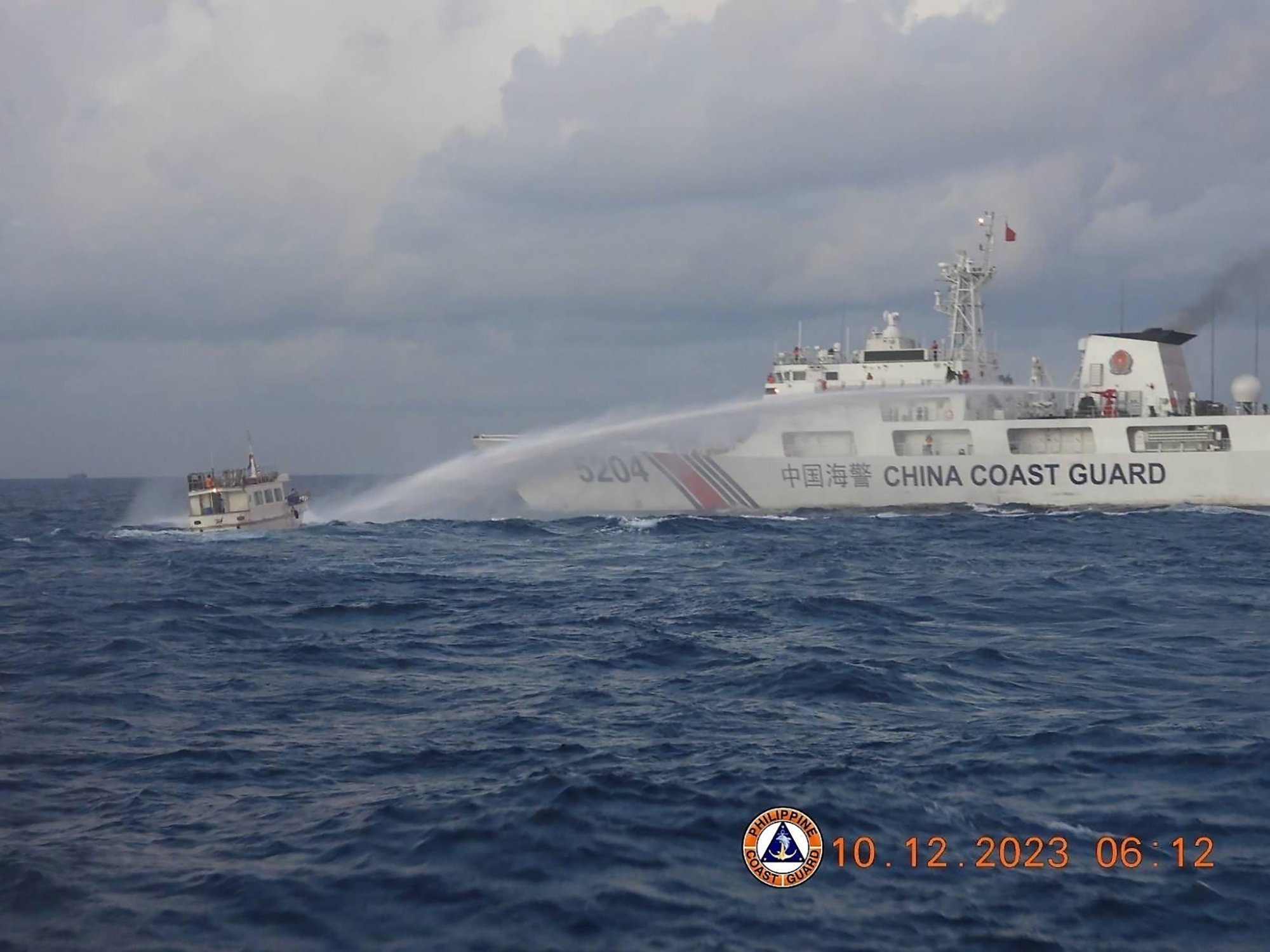
South China Sea: Beijing flexes maritime muscles as Manila’s ‘assertive transparency’ puts it on the defensive
- ‘China is escalating’ as its vessels make show of force near disputed reef where rusty second world warship serves as Philippine outpost, analysts say
- However, observers say Beijing must carefully calibrate its actions to avoid drawing in the US to defend its Southeast Asian ally
China has appeared taken aback by the Philippines, which is taking a more direct approach in confronting Beijing and its massive and heavily armed patrol boats.
In an incident earlier this month, Chinese Coast Guard ships fired high-intensity water cannons at a ship with journalists on board, which had been deployed by the Philippine fisheries bureau on a mission to provide fuel to fishermen near the contested Scarborough Shoal, known in Chinese as Huangyan Island.

The triangular chain of reefs and rocks in the South China Sea was taken over by China after a tense maritime stand-off 11 years ago.
“It’s a very strange phenomenon that the comparison of military powers between China and the Philippines is now completely reversed with our current situation at sea,” said Chen Xiangmiao, an associate researcher with the National Institute for South China Sea Studies in the southern island province of Hainan.
Collin Koh, a senior fellow at the S Rajaratnam School of International Studies at Singapore’s Nanyang Technological University, said Manila’s tactics had so far been effective.
“It may not have compelled Beijing to roll back its actions in the South China Sea, but at least one can say it might have deterred China from upping the ante via vertical escalation,” he said, referring to the process of taking even more drastic actions such as the use of force.
This has left China with limited options, prompting Beijing to carefully calibrate its response and avoiding crossing the “armed attack” threshold, which could invoke the US-Philippines Mutual Defence Treaty, Koh added.
“So while not rolling back these actions which could lead to obvious domestic political repercussions due to China looking weak, Beijing also finds itself struggling with persisting with the existing set of options below that threshold of armed attack,” he said.
“All in all, we see some sort of a stalemate.”
Pressure mounts on China as Philippines says it will never give an inch
The tactics reflect the calculations of Beijing and Manila, according to Ray Powell, director of SeaLight, a project at the Gordian Knot Centre for National Security Innovation at Stanford University, which monitors maritime activities in the South China Sea.
He said Manila, with its much smaller maritime security force, believed that its best defence was to publicise Beijing’s actions.
“This has resulted in commitments of increased maritime funding from its own legislature and moral support from partner nations,” said Powell, who dubbed the strategy “assertive transparency”.
Meanwhile, Beijing has decided to convince Manila that the risks of continuing this strategy outweigh the benefits, according to Powell.
“How long and how much it keeps on this course depends on how long it can endure the reputational harm it is suffering and whether it believes Manila will blink first,” Powell said.
Some believe Beijing is playing the long game until the day the rusting warship falls apart on its own, which would force the Philippines to evacuate the Second Thomas Shoal.
Others said China was attempting to bait Manila into firing the first shot, which Koh said “would then legitimise Beijing to escalate as a ‘self-defensive measure’”.
“This explains the [Philippine] wariness against taking risks that could legitimise the Chinese to resort to more drastic actions.”
Will more assertive Philippine approach to South China Sea pay off?
There are signs that Beijing is changing its tactics.
In what appeared to be “a calculated show of force”, 11 Chinese vessels were spotted inside the Second Thomas Shoal on December 11 while dozens more clustered around the exterior, according to SeaLight, Powell’s project.
Citing images from satellite geospatial imagery provider Planet Labs, SeaLight said two of the Chinese ships were seen as close as 2km (1.2 miles) south of the Sierra Madre.
This came after two separate confrontations between Chinese and Philippine vessels – one near Scarborough Shoal on December 9 and another a day later near the Second Thomas Shoal.
SeaLight called the Chinese ships’ advance towards the Second Thomas Shoal “highly unusual”, because Chinese vessels typically return promptly to the Mischief Reef base nearby when Philippine resupply boats and their escorts depart.
“It’s quite rare to see [Chinese] vessels enter the shoal’s interior at all, but 11 is certainly the highest number we’ve yet observed at SeaLight,” Powell wrote. “China is escalating.”
Koh agreed that the unprecedented number of Chinese ships within the Second Thomas Shoal “represented a serious escalation” by China.
“All this while the Chinese forces have maintained a stand-off distance from the shoal, but now it appears they’re probably seeking to establish a tighter cordon – or at least making the first initial steps to do so, in a gradual manner,” he said.
However, it remains to be seen how far Beijing and Manila could go, Powell said.
“For example, does the Philippines attempt to resupply the BRP Sierra Madre by another method, or does China attempt to use other instruments like economic coercion to increase the pressure?” he asked.
Additional reporting by Amber Wang


